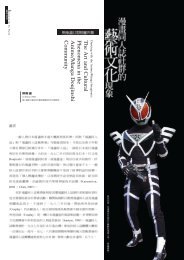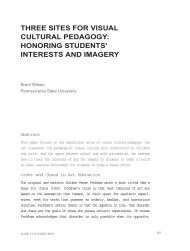Being-there: an Existentialism Point of View in Egon Schiele's Self ...
Being-there: an Existentialism Point of View in Egon Schiele's Self ...
Being-there: an Existentialism Point of View in Egon Schiele's Self ...
Create successful ePaper yourself
Turn your PDF publications into a flip-book with our unique Google optimized e-Paper software.
國際藝術教育學刊<br />
<strong>Be<strong>in</strong>g</strong>-<strong>there</strong>: <strong>an</strong><br />
<strong>Existentialism</strong> <strong>Po<strong>in</strong>t</strong> <strong>of</strong><br />
<strong>View</strong> <strong>in</strong> <strong>Egon</strong> <strong>Schiele's</strong><br />
<strong>Self</strong>-portraits<br />
156<br />
by the contradiction. Just as his friend He<strong>in</strong>rich Benesch has said:<br />
(Whitford, 1981:66)<br />
The basic trait <strong>of</strong> [Schiele’s] character was seriousness!not the bleak,<br />
mel<strong>an</strong>choly seriousness which h<strong>an</strong>gs its head, but the quiet seriousness<br />
<strong>of</strong> a person dom<strong>in</strong>ated by a spiritual mission. Everyday matters could not<br />
affect him. He always looked beyond them towards the elevated goal <strong>of</strong><br />
his ambition.<br />
Schiele also said the follow<strong>in</strong>g words:(Ste<strong>in</strong>er,1993:27-28)<br />
The new artist is <strong>an</strong>d must at all costs be himself he must be a creator<br />
he must build the foundation himself without reference to the past to<br />
tradition. The he is a new artist.<br />
Schiele f<strong>in</strong>ally surpassed the past pa<strong>in</strong>ful experience <strong>an</strong>d<br />
confirmed his value <strong>an</strong>d arts, which we c<strong>an</strong> see from his pa<strong>in</strong>t<strong>in</strong>gs<br />
[ill. 10]<br />
<strong>Self</strong>-portrait, 1912 Oil on<br />
c<strong>an</strong>vas 42.2 × 33.7㎝ Private<br />
collection<br />
4. Results <strong>an</strong>d Conclusions<br />
[ill. 11]<br />
The prophet, 1911 Oil on<br />
c<strong>an</strong>vas 80.5 × 80㎝ Private<br />
collection<br />
[ill. 12]<br />
<strong>Self</strong>-portrait with black clay vase, 1911<br />
Oil on wooden p<strong>an</strong>el 27.5 × 34㎝<br />
Historisches Museum der Stadt Wien<br />
The Orig<strong>in</strong> <strong>of</strong> the Work <strong>of</strong> Art has po<strong>in</strong>ted out that Works <strong>of</strong> art are<br />
not merely representations <strong>of</strong> the way th<strong>in</strong>gs are, but actually produce a<br />
community’s shared underst<strong>an</strong>d<strong>in</strong>g. The nature <strong>of</strong> art must be reveal<strong>in</strong>g<br />
the true existence. It is emphasized aga<strong>in</strong> <strong>an</strong>d aga<strong>in</strong> that each time a<br />
new artwork is added to <strong>an</strong>y culture, the me<strong>an</strong><strong>in</strong>g <strong>of</strong> what it is to exist<br />
is <strong>in</strong>herently ch<strong>an</strong>ged. The artwork <strong>an</strong>d the artist, he expla<strong>in</strong>s, exist<br />
<strong>in</strong> a dynamic where each appears a provider <strong>of</strong> the other—“Neither<br />
InJAE 5.1 © NTAEC 2007





